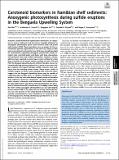| dc.contributor.author | Ma, Jian | |
| dc.contributor.author | French, Katherine L | |
| dc.contributor.author | Cui, Xingqian | |
| dc.contributor.author | Bryant, Donald A | |
| dc.contributor.author | Summons, Roger E | |
| dc.date.accessioned | 2022-01-18T16:43:47Z | |
| dc.date.available | 2021-10-27T19:56:55Z | |
| dc.date.available | 2022-01-18T16:43:47Z | |
| dc.date.issued | 2021-07 | |
| dc.identifier.issn | 1091-6490 | |
| dc.identifier.issn | 0027-8424 | |
| dc.identifier.uri | https://hdl.handle.net/1721.1/133837.2 | |
| dc.description.abstract | <jats:p>Aromatic carotenoid-derived hydrocarbon biomarkers are ubiquitous in ancient sediments and oils and are typically attributed to anoxygenic phototrophic green sulfur bacteria (GSB) and purple sulfur bacteria (PSB). These biomarkers serve as proxies for the environmental growth requirements of PSB and GSB, namely euxinic waters extending into the photic zone. Until now, prevailing models for environments supporting anoxygenic phototrophs include microbial mats, restricted basins and fjords with deep chemoclines, and meromictic lakes with shallow chemoclines. However, carotenoids have been reported in ancient open marine settings for which there currently are no known modern analogs that host GSB and PSB. The Benguela Upwelling System offshore Namibia, known for exceptionally high primary productivity, is prone to recurrent toxic gas eruptions whereupon hydrogen sulfide emanates from sediments into the overlying water column. These events, visible in satellite imagery as water masses clouded with elemental sulfur, suggest that the Benguela Upwelling System may be capable of supporting GSB and PSB. Here, we compare distributions of biomarkers in the free and sulfur-bound organic matter of Namibian shelf sediments. Numerous compounds—including acyclic isoprenoids, steranes, triterpanes, and carotenoids—were released from the polar lipid fractions upon Raney nickel desulfurization. The prevalence of isorenieratane and β-isorenieratane in sampling stations along the shelf verified anoxygenic photosynthesis by low-light-adapted, brown-colored GSB in this open marine setting. Renierapurpurane was also present in the sulfur-bound carotenoids and was typically accompanied by lower abundances of renieratane and β-renierapurpurane, thereby identifying cyanobacteria as an additional aromatic carotenoid source.</jats:p> | en_US |
| dc.language.iso | en | |
| dc.publisher | National Academy of Sciences | en_US |
| dc.relation.isversionof | http://dx.doi.org/10.1073/pnas.2106040118 | en_US |
| dc.rights | Article is made available in accordance with the publisher's policy and may be subject to US copyright law. Please refer to the publisher's site for terms of use. | en_US |
| dc.source | PNAS | en_US |
| dc.title | Carotenoid biomarkers in Namibian shelf sediments: Anoxygenic photosynthesis during sulfide eruptions in the Benguela Upwelling System | en_US |
| dc.type | Article | en_US |
| dc.contributor.department | Massachusetts Institute of Technology. Department of Earth, Atmospheric, and Planetary Sciences | |
| dc.relation.journal | Proceedings of the National Academy of Sciences | en_US |
| dc.eprint.version | Final published version | en_US |
| dc.type.uri | http://purl.org/eprint/type/JournalArticle | en_US |
| eprint.status | http://purl.org/eprint/status/PeerReviewed | en_US |
| dc.date.updated | 2021-09-23T16:04:54Z | |
| dspace.orderedauthors | Ma, J; French, KL; Cui, X; Bryant, DA; Summons, RE | en_US |
| dspace.date.submission | 2021-09-23T16:04:56Z | |
| mit.journal.volume | 118 | en_US |
| mit.journal.issue | 29 | en_US |
| mit.license | PUBLISHER_POLICY | |
| mit.metadata.status | Authority Work Needed | en_US |
